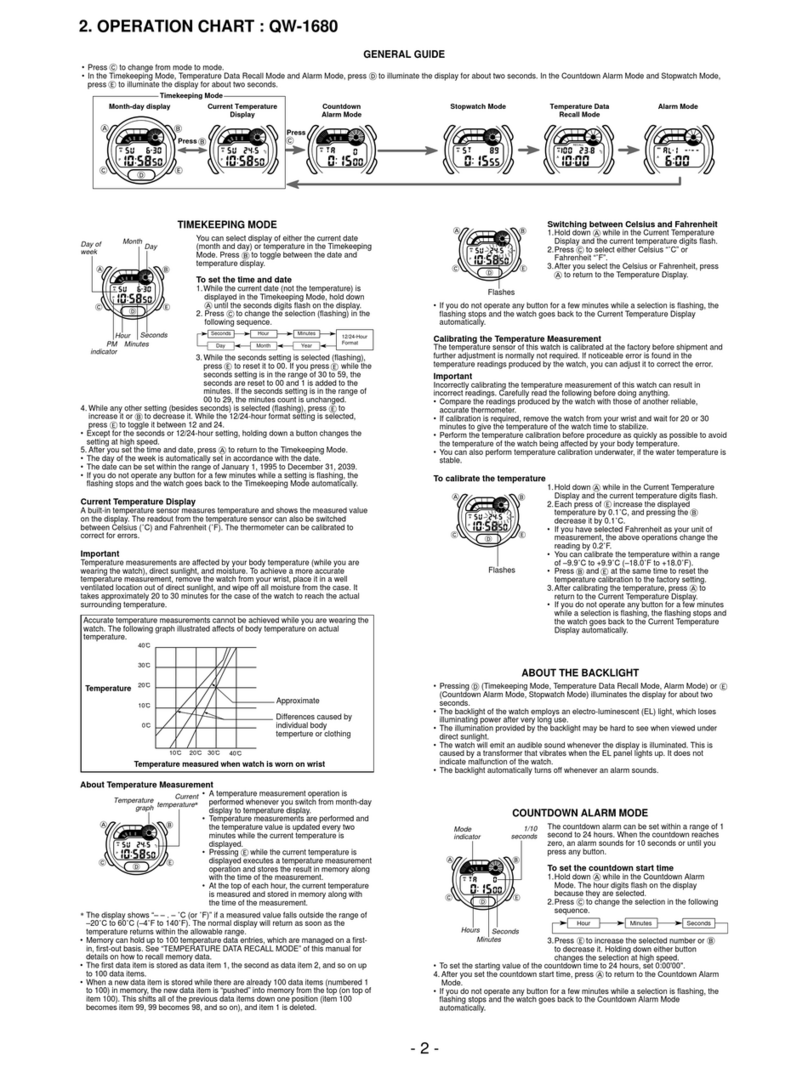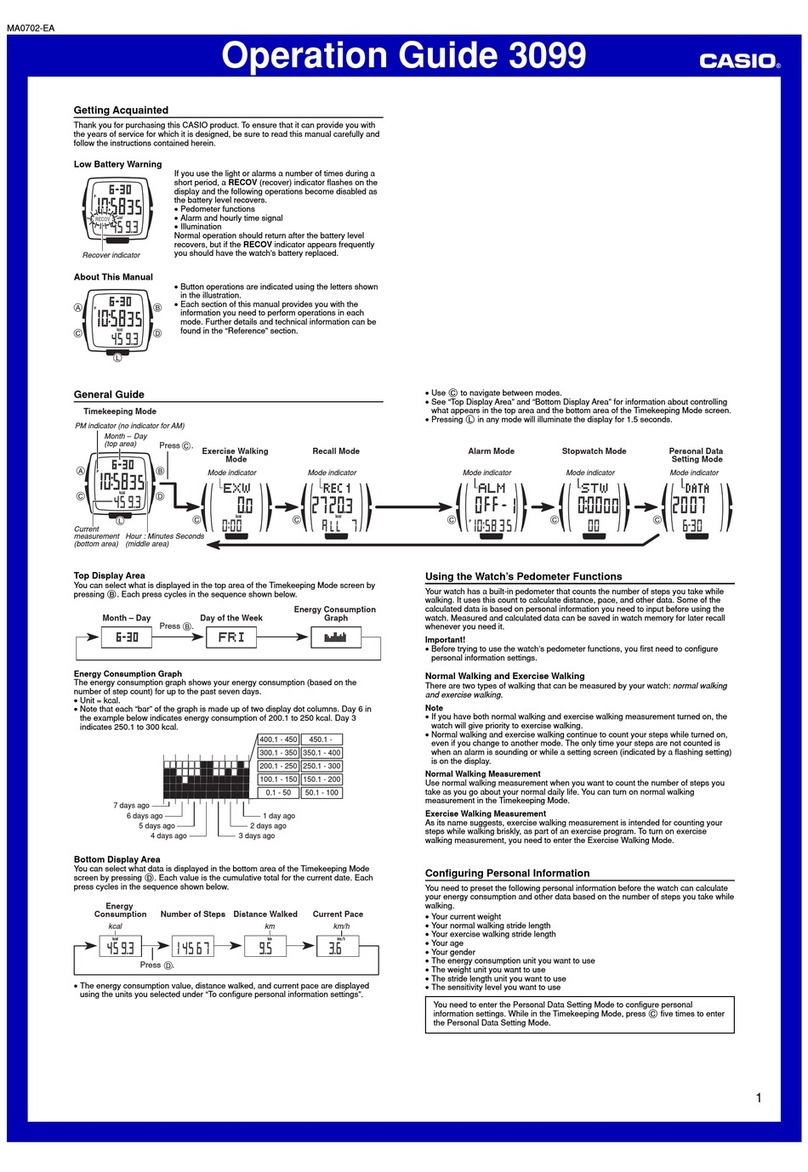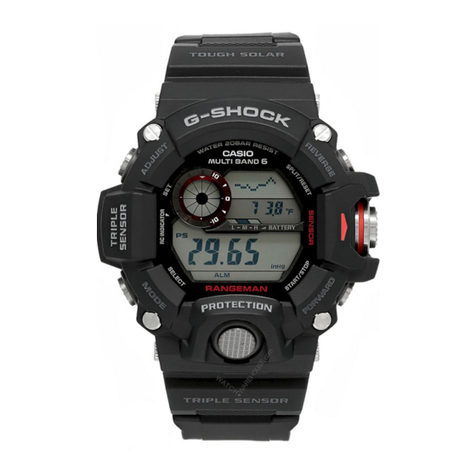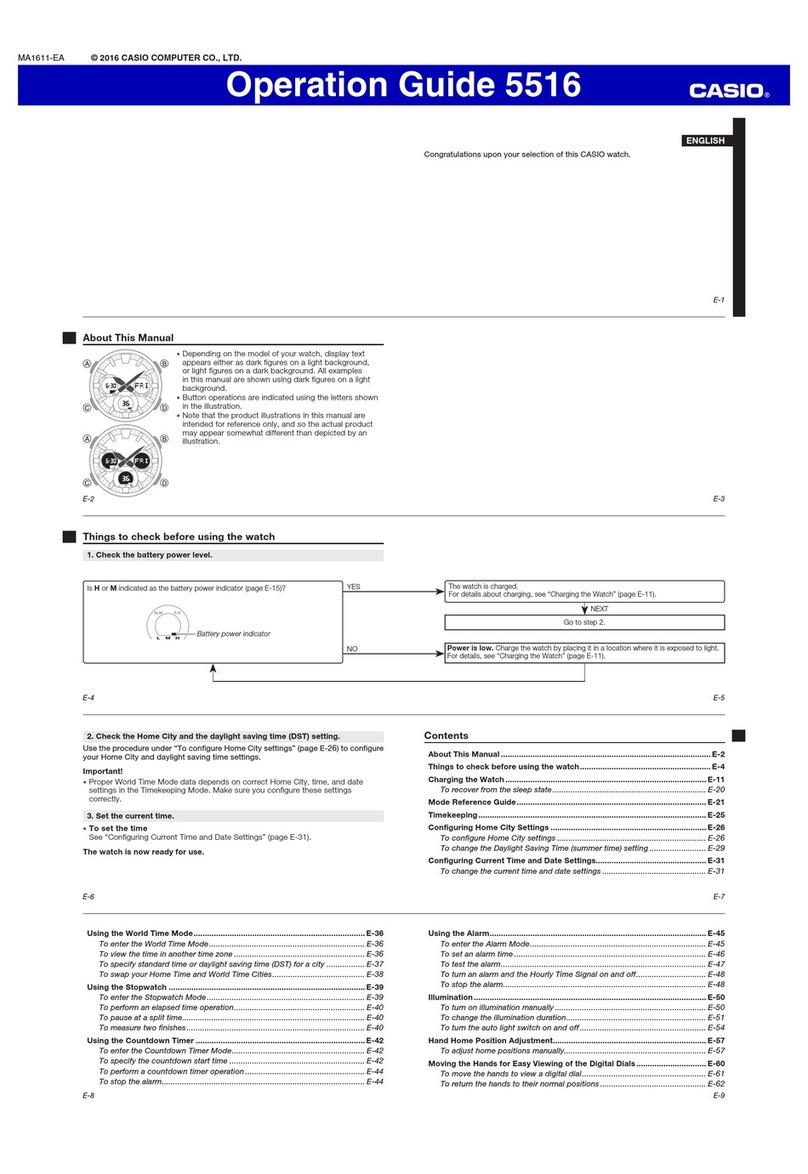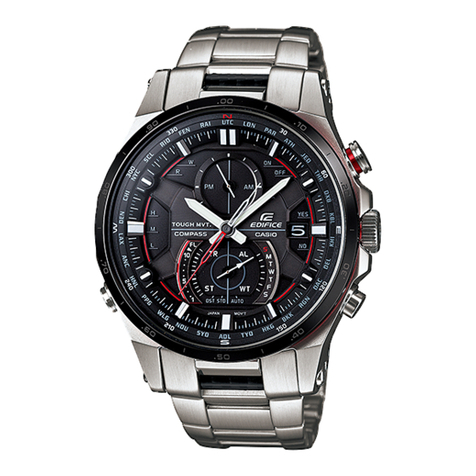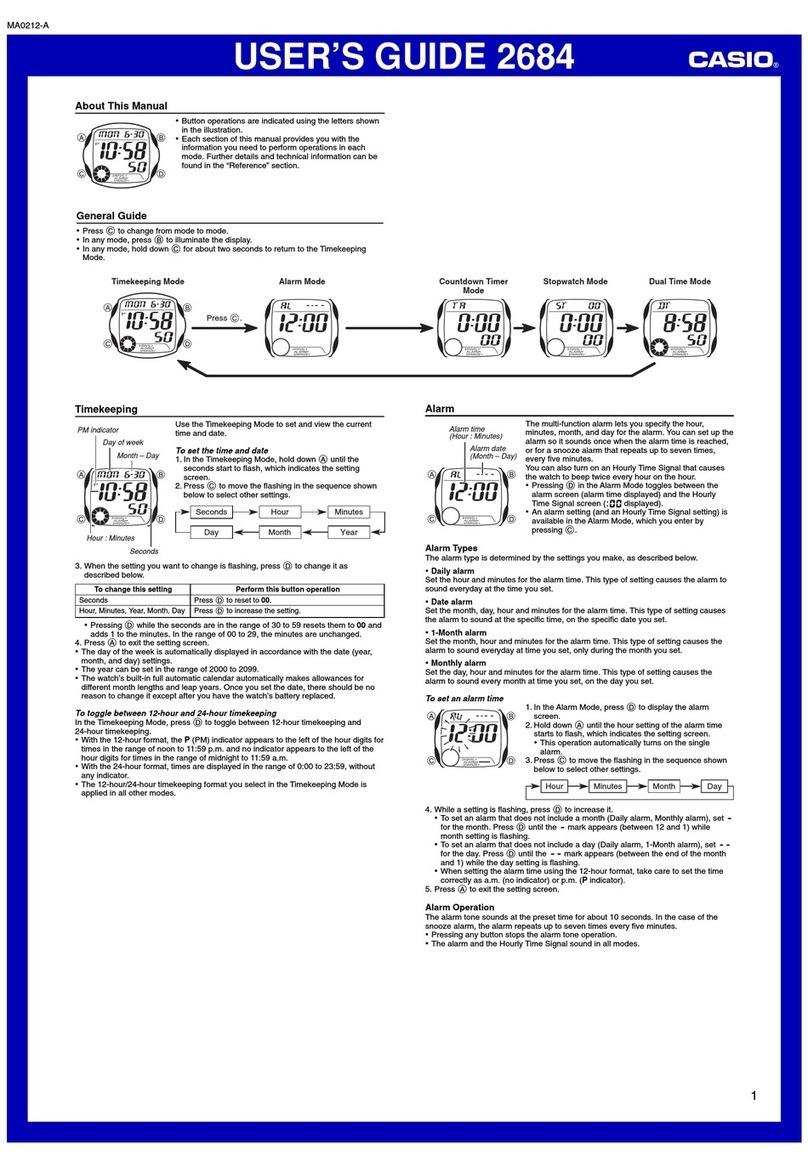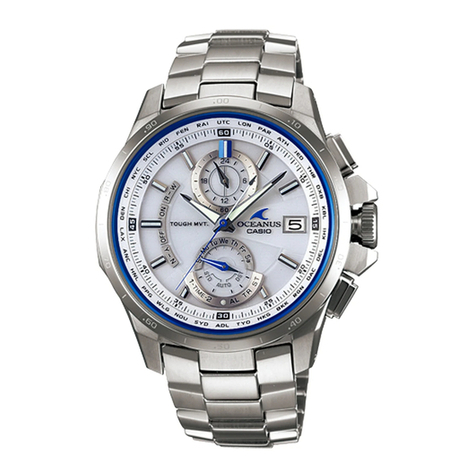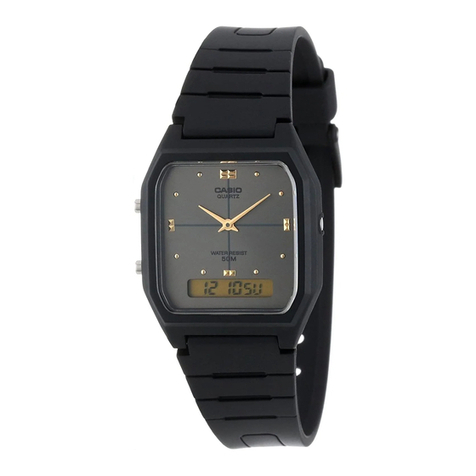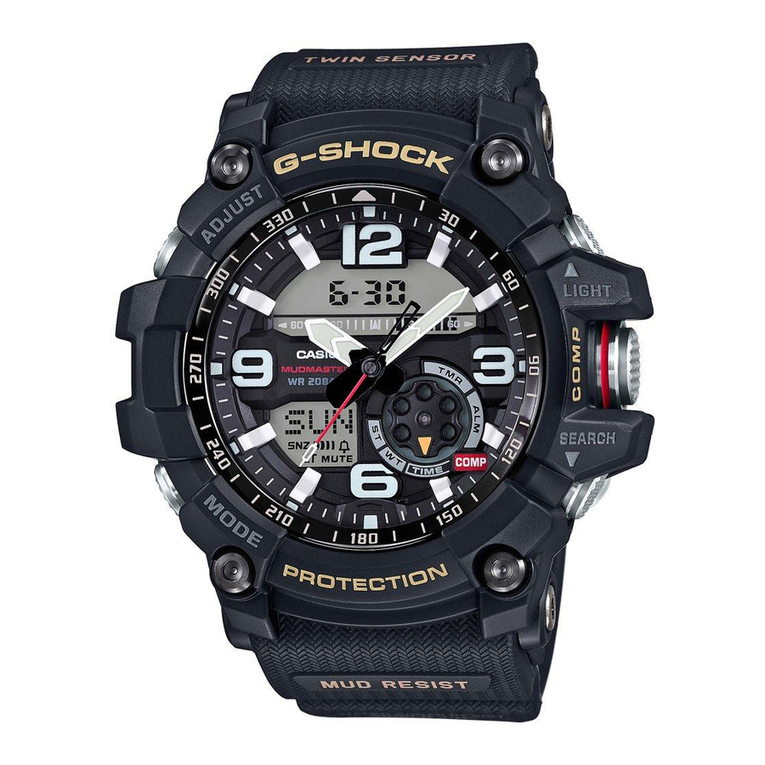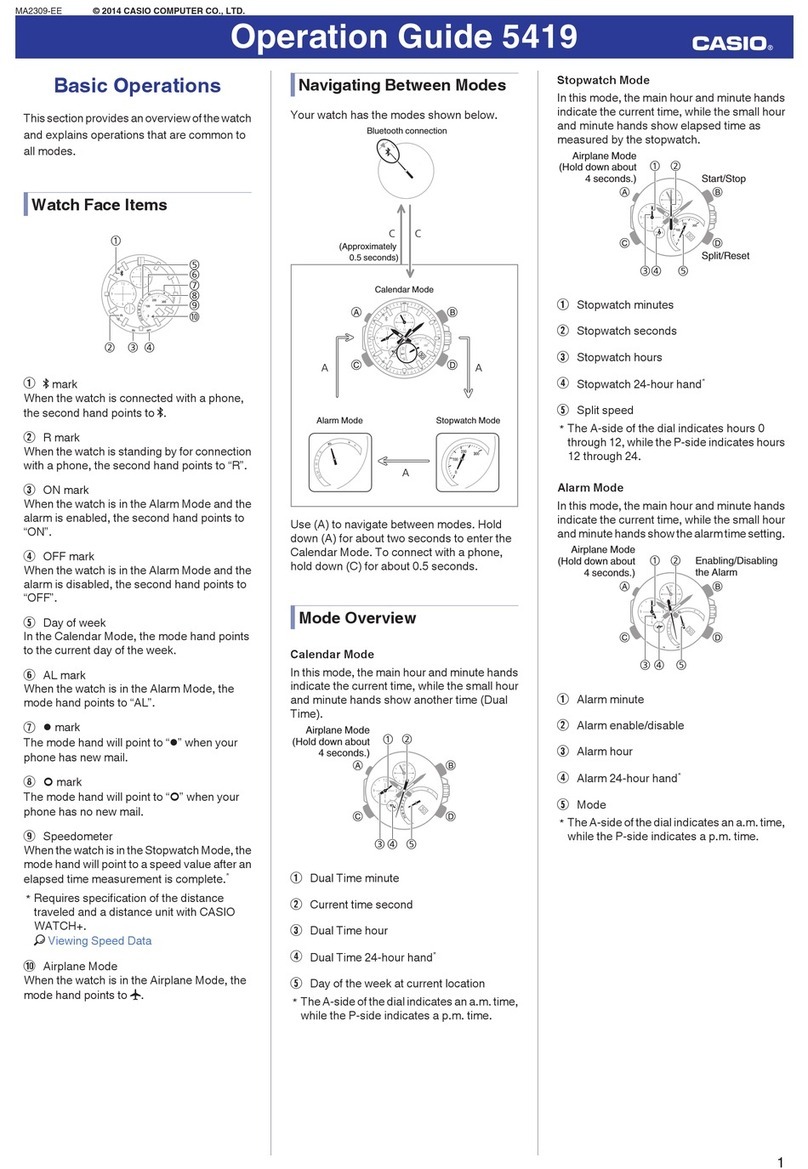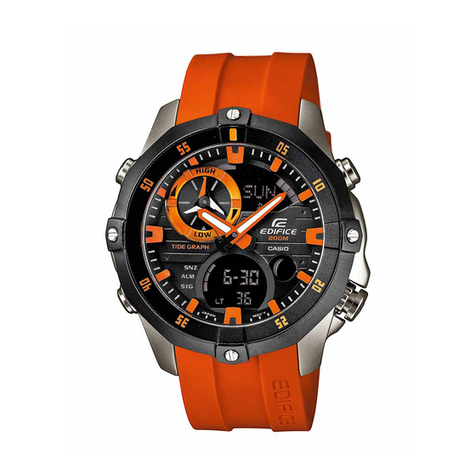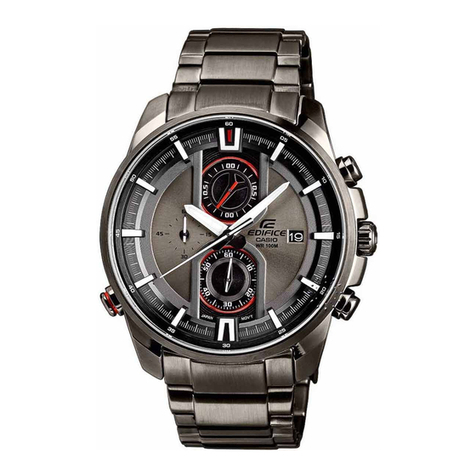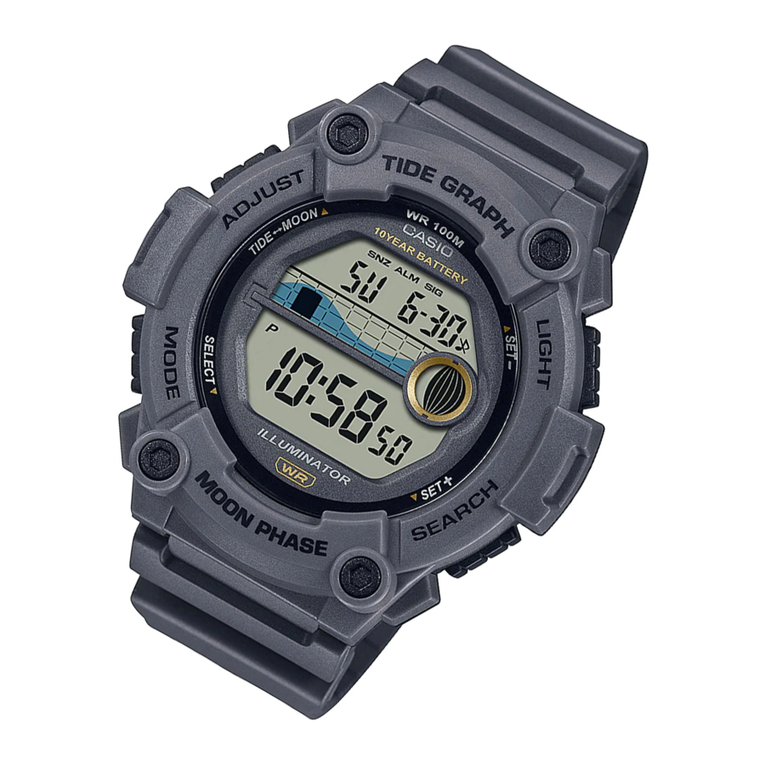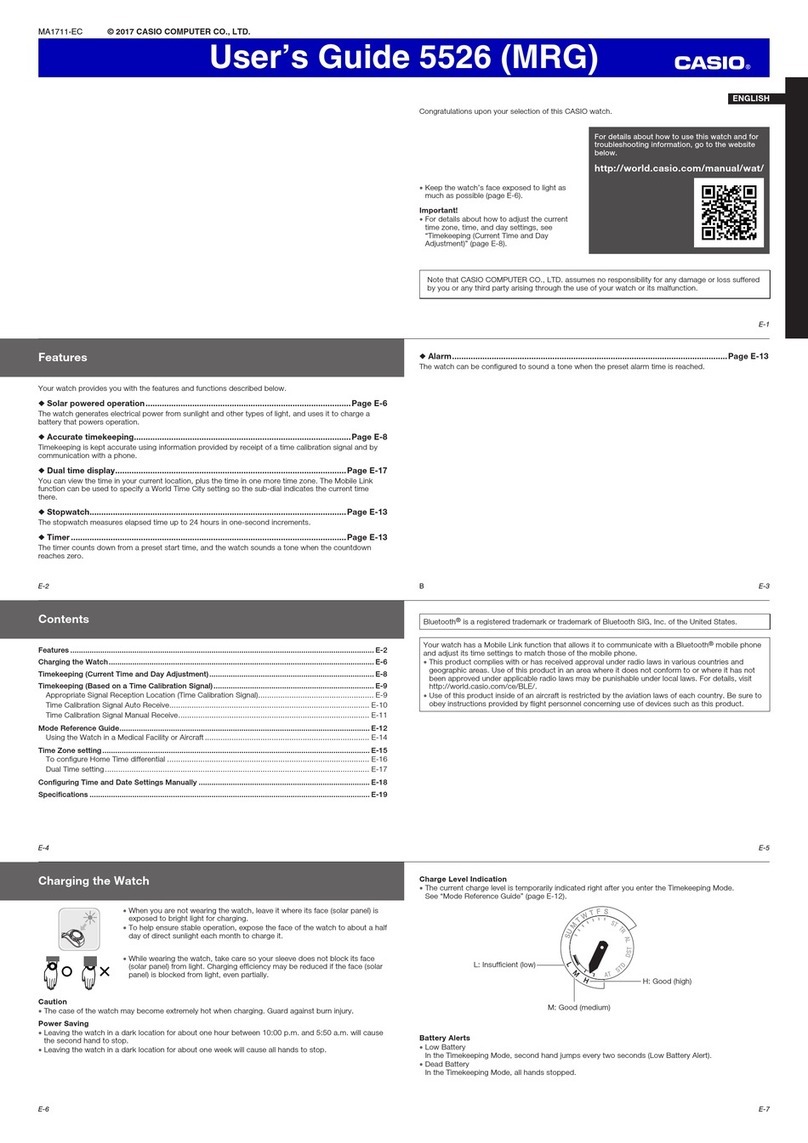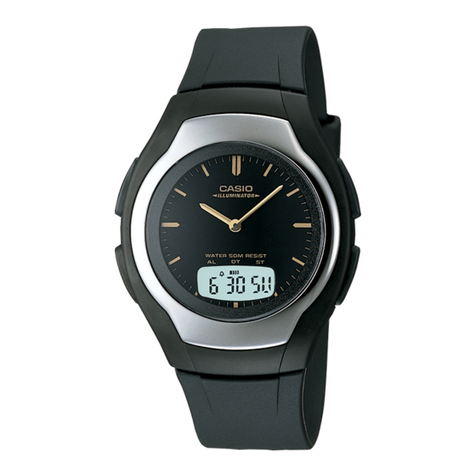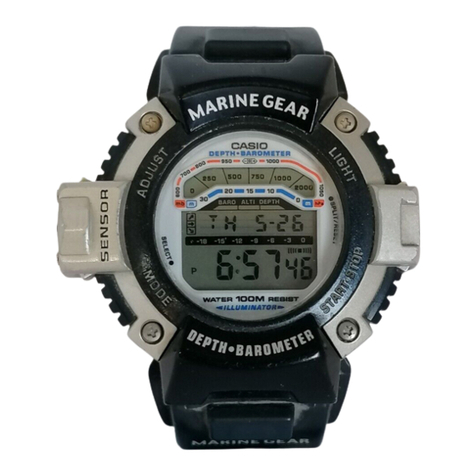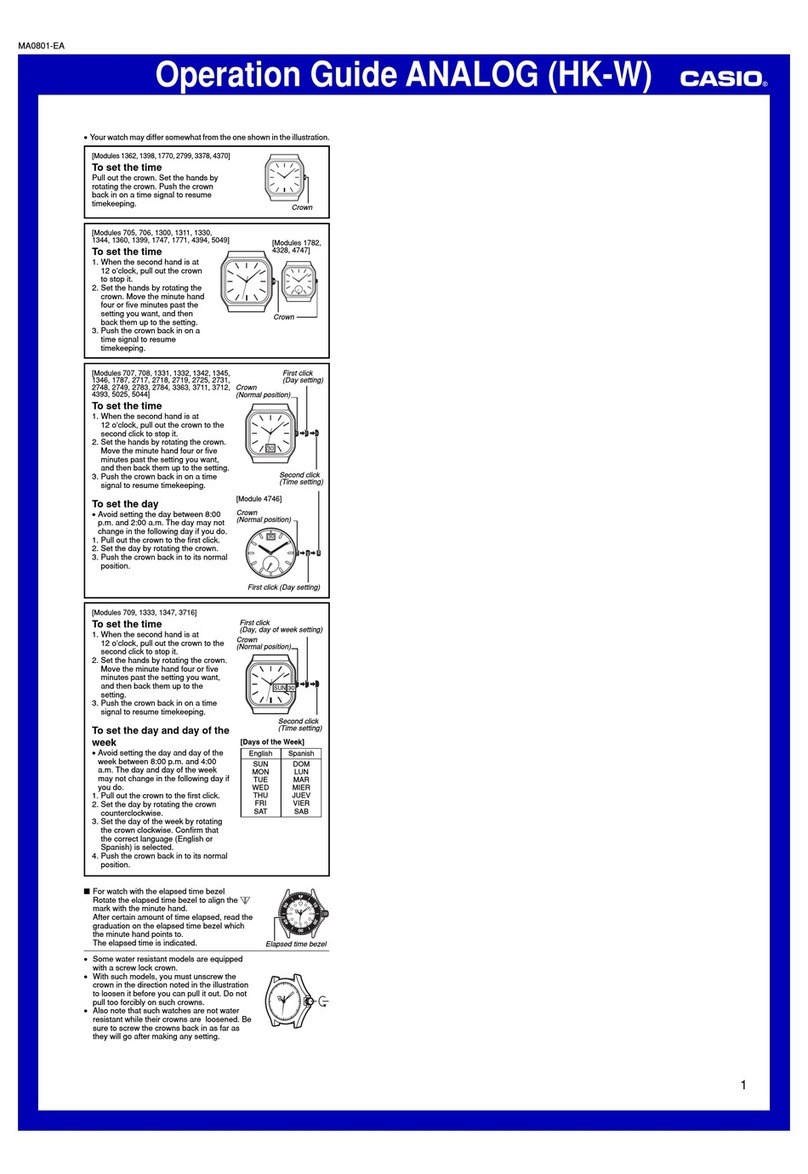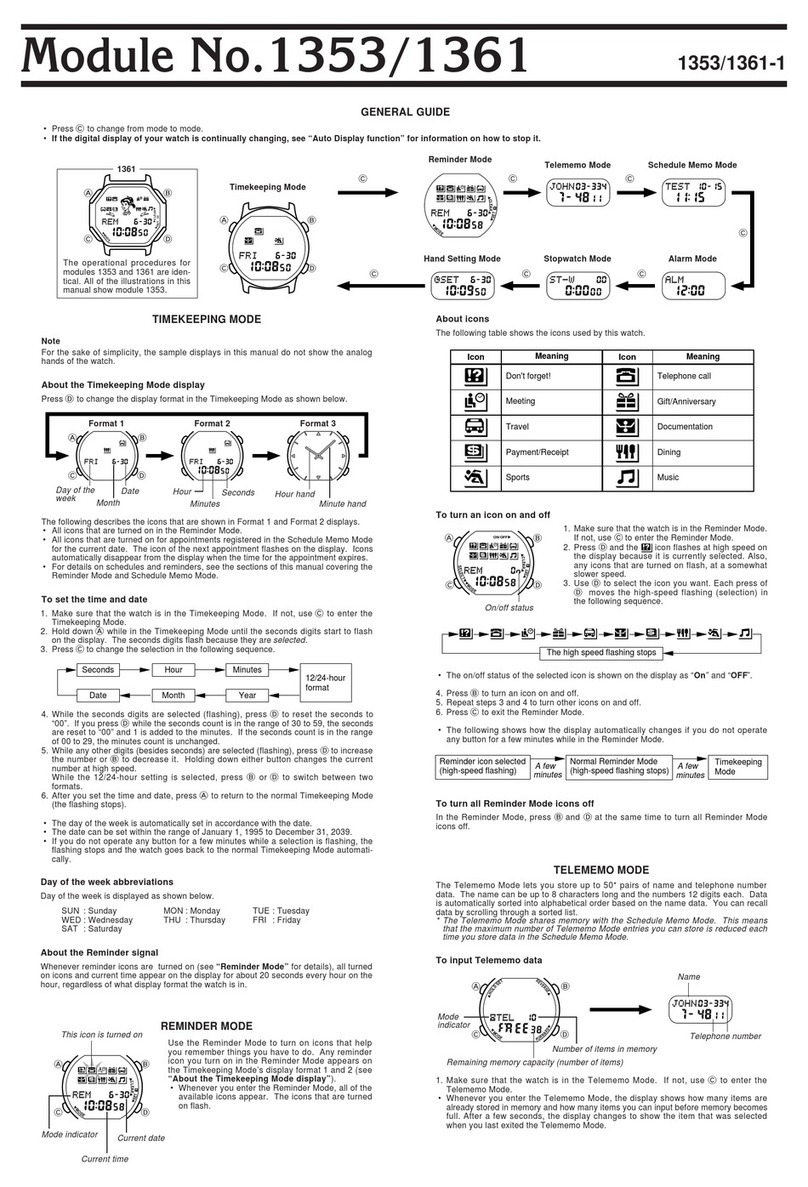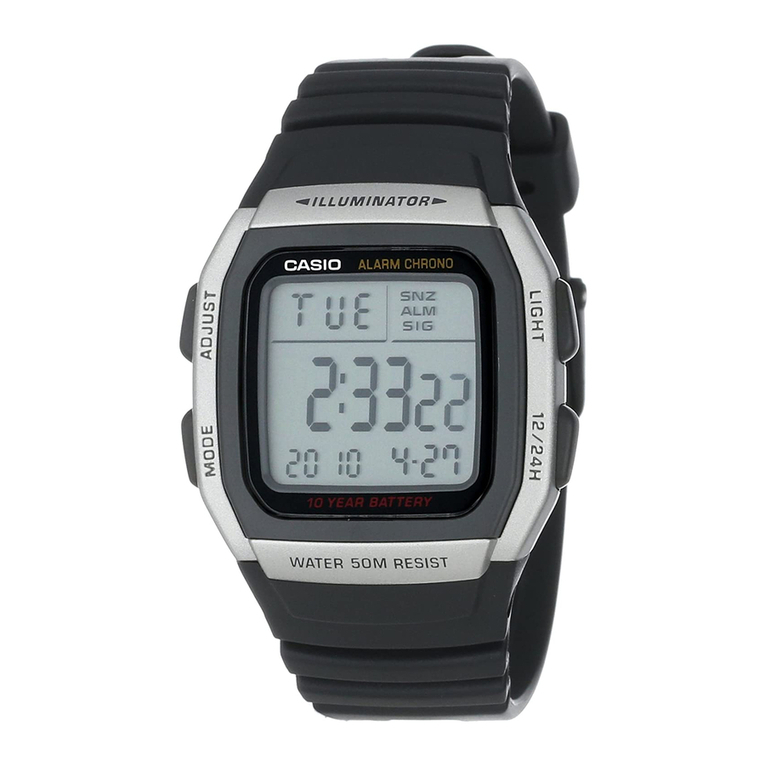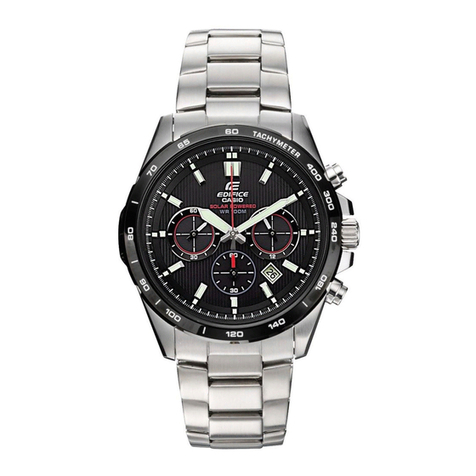
—3 —
ou can use the Recall Mode to vie
y the name of the activity y
Each press of
•After you input your basic data and specify the calorie memory timing, you should
also specify the name of activity you are performing. Calories you burn are then
calculated in accordance with settings you configure. For details, see “Activities”and
“Calorie Measurements”.
•Calorie Meter Mode data is stored in memory using the current Timekeeping Mode
time and date.Do not change the time and date setting while a calorie measurement
operation is in progress.
•See “Exercising for Optimal Health”for important information about using Sports
Calorie Meter functions effectively.
Activities
For proper operation of the Calorie Meter Mode, you need to specify the name of
activity you will be performing before starting a calorie measurement operation.You
can specify any one of the following 43 activities.
L
L
, ,
H
H
, ,
,
L
LL
, , , , ,
, ,
H
, , , , ,
m
,
, , , , ,
,
1
, , ,
, , ,
, , , , , , ,
, , , , ,
•Some activities appear more than once, with the letters
L
,
m
, and
H
next to them.
These letters indicate exercise load, as Low (
L
), Medium (
m
), or High (
H
).
•The values to the right of the line of asterisks indicate exercise intensity.The
larger the value, the greater the load.
•For more information about the load level for each activity, see “Activity Types and
Intensities”.
To specify an activity
1.In the Calorie Meter Mode, make sure no calorie
measurement oper ation is being performed.
•If a measurement operation is in progress, press E
to stop it.
2.Use Dto select the activity you want.
•D cycles through the preset activities.
Displa ou want to select.
•If the full name of an activity cannot fit on the display, it
scrolls once from right to left. After scrolling the first four
characters of the activity name remain on the display.
•The watch remembers the activities you select.For
details, see “Using Favorite Activity Memory”.
Activity name
Calorie Measurements
You need to start and stop the calorie measurement operation when you start and
stop exercising, playing a sport, etc.
The watch displays the elapsed time, number of calories burned, and the calorie
target graph while a calorie measurement is in progress.The watch beeps for five
seconds when the number of calories burned reaches the calorie target you preset.
•Your burned calorie value is stored in memory (as daily data) when you stop the
calorie measurement operation.
•Note that the calorie measurement operation continues even if you exit the Calorie
Meter Mode.If you exit the Calorie Meter Mode with data on the display while the
measurement operation is stopped, the data will still be on the display when you
next enter the Calorie Meter Mode.This means you can accumulate data for multiple
calorie measurement operations during a single day.
•If you are engaged in an activity that has rest periods or if you perform more than
one activity and want to keep track of the cumulative elapsed time and calorie totals
in the Calorie Meter Mode, do not clear the display to all zeroes when you stop
measurement during rest periods, etc.
If you want to keep track of data for each individual session, clear the display to all
zeroes each time you stop the measurement operation.
To display the cumulative total data of multiple measurements:
Start
➔
Stop; Start
➔
Stop; Start
➔
Stop.....Clear (all-zero reset)
To display the data for each measurement:
Start
➔
Stop
➔
Clear; Start
➔
Stop
➔
Clear;.......
To perform calorie measurement
1.In the Calorie Meter Mode, use Dto select the name
of the activity you are about to perform.
•Note that you cannot change the selected activity
once the calorie measurement operation starts.To
change the activity, you first need to press Eto stop
the measurement operation.
•Pressing Ainstead of Dwill scroll through the
contents of Favorite Activity memory (if it contains any
activities). For more information, see “Using Favorite
Activity Memory”.
2.Press Eto start the calorie measurement operation,
and then start your activity.
•To view the currently selected activity in place of the
current calorie value, hold down A.
3.After you are finished with your activity, press Eto stop
the measurement operation.
Target
graph
Elapsed time
(hours, minutes,
seconds)
Current
calories Activity name
•While the measurement operation is stopped, the display alternates at two-second
intervals between the current calorie value and the activity name. In this case, only
the first four characters of the activity name are displayed, without scrolling.
•Pressing Eto stop the measurement operation causes the data to be stored in
memory. Pressing B while measurement is stopped clears the display to all zeroes.
•Y w data stored in memory.
Note
•The displayed current calorie value is updated every 10 seconds.
•During measurement, the target graph shows how much progress you have made
toward achieving your target calorie level for the current date. One segment of the
graph is darkened each time you burn 10% of the total target calorie amount for the
day.No segments are darkened when your current calorie value is less than 10% of
the target total.
•The target graph for the current date is also displayed in the Timekeeping Mode.
•You can view the calorie target countdown in the Timekeeping Mode. See “To view
Timekeeping Mode sub-screens”for more information.
•The watch performs either of the following operations whenever the calorie memory
timing you specified is reached.
If Calorie Measurement is in progress:The current data is stored automatically in
memory, and measurement is restarted from zero.
If Calorie Measurement is stopped: Current measurement data is stored in calorie
memory and the Calorie Meter Mode display is reset to all zeroes.
•A measurement operation is stopped automatically whenever the elapsed time
exceeds 23 hours.
•Any time the calorie total exceeds 9,999.99 kcal (or 99,999.9 kJ), calorie
measurement restarts from zero.
•If you make an operational mistake while performing a calorie measurement
(selecting the wrong activity, forgetting to stop measurement during a break, etc.),
you can delete the data by stopping the measurement operation and deleting the
daily record for the current date.Next, re-start measurement for the current date
from zero. See “Recall Mode”for information about deleting the current date’s data.
Using Favorite Activity Memory
The watch remembers up to five of the last activities you selected when you
performed past calorie measurement operations.You can use Favorite Activity
memory to select your most often used activities quickly and easily.
•To display Favorite Activity memory contents, press Ain the Calorie Meter Mode
while measurement is stopped.
•An activity is not added to Favorite Activity memory if it is already there.
•If Favorite Activity memory is already full, performing a measurement operation with
a new activity causes the oldest Favorite Activity to be replaced with the new one.
•You can use the following procedure to clear Favorite Activity memory contents.
To clear Favorite Activity memory contents
1. In the Calorie Meter Mode, make sure no calorie measurement operation is being
performed.
2. Press Aand Dat the same time.
•This causes
CLR
to appear on the display, and selects low-load aerobics
(
AERO
L
) as the activity type.
Recall Mode
Use the Recall Mode to recall and delete data stored by
Calorie Meter Mode operation.
•All of the operations in this section are performed in the
Recall Mode, which you enter by pressing C.
About Memory Management
The watch maintains three types of Calorie Meter Mode
records: Daily, Weekly, and Cumulative.The timing when
data is stored to memory depends on the record type, as
explained below.
Daily records
Daily records contain the following information for today,
and for each of the six days prior to today.
Target graph, month, day, day of the week, calories
burned, and elapsed time (hours, minutes, seconds).
Target graph
Month –Day
Day of
week
Time
Calories burned
Daily Record
Daily record data also includes calories burned and elapsed times for up to seven
activities that were selected during the current date and the previous date.
Data for the current date’s daily record is stored whenever you stop a measurement
operation in the Calorie Meter Mode.The current date’s daily record expires (becomes
yesterday’s record) at time you have specified as the calorie memory timing.
•If a daily record is stored while there are already seven daily records in memory, the
oldest record is deleted automatically to make room for the new record.
Weekly records
Weekly records contain the following information for up to 11 previous weeks of
Calorie Meter Mode measurements.
Target graph, calories burned, elapsed time (hours, minutes, seconds)
Data for a weekly record is stored on Monday morning at the time you have specified
as the calorie memory timing.
•If a weekly record is stored while there are already 11 weekly records in memory,
the oldest record is deleted automatically to make room for the new record.
Cumulative record
The cumulative record keeps a running total of calories burned and elapsed time
(hours and minutes) since the cumulative record was last cleared.
Data is saved to the cumulative record each day at the time you have specified as the
calorie memory timing.
Note
•Data save operations are based on the current time and date as kept in the
Timekeeping Mode.
•See “To set the time and date”for information about specifying the calorie memory
timing.
To recall Calorie Meter Mode records
In the Recall Mode, use the A, D, and Ebuttons to navigate among records a
shown below.
L
From one day
previous to
six days
previous
From two weeks
previous to 11
weeks previous
Oldest
Activity
Today’s Daily Record
Newest Activity
Cumulative Record
PreviousWeek’s
Weekly Record
PressD.
Press E.
Today’s daily record appears first when you enter the Recall Mode.
•The daily record screen initially alternates between the date, and cumulative number
of calories burned and elapsed time for that date.
•While today’s or yesterday’s daily record is on the display, you can press Dto
display calories burned and elapsed time for each activity.
•The weekly record screen alternates between the cumulative total calories for the
week and the week number (from = previous week to = 11 weeks
previous).
•Note that ––is displayed for any record that has not been used yet.
AERO
m
m
m
mH
HLmH
23456
789 10 11 12 13
14 15 16 17 18 19
****
L
▲
▲
AERO
▲
▲
▲
▲
▲
Press A.
▲
▲
▲
▲
#01W TTL
•
#01W #11W
**** **** **** **** ****
**** **** **** **** **** **** ****
**** **** **** ****
RUN
AEROBICS AEROBICS AEROBICS BASEBALL
BASKETBALL
JOG JOG JOG
BIKE BIKE FOOTBALL GOLF
RUN RUN SWIM SWIM
SWIM TENNIS WALK WALK WALK
TRAINING
REC
****
BIKE
WEIGHT
****
****
▲
